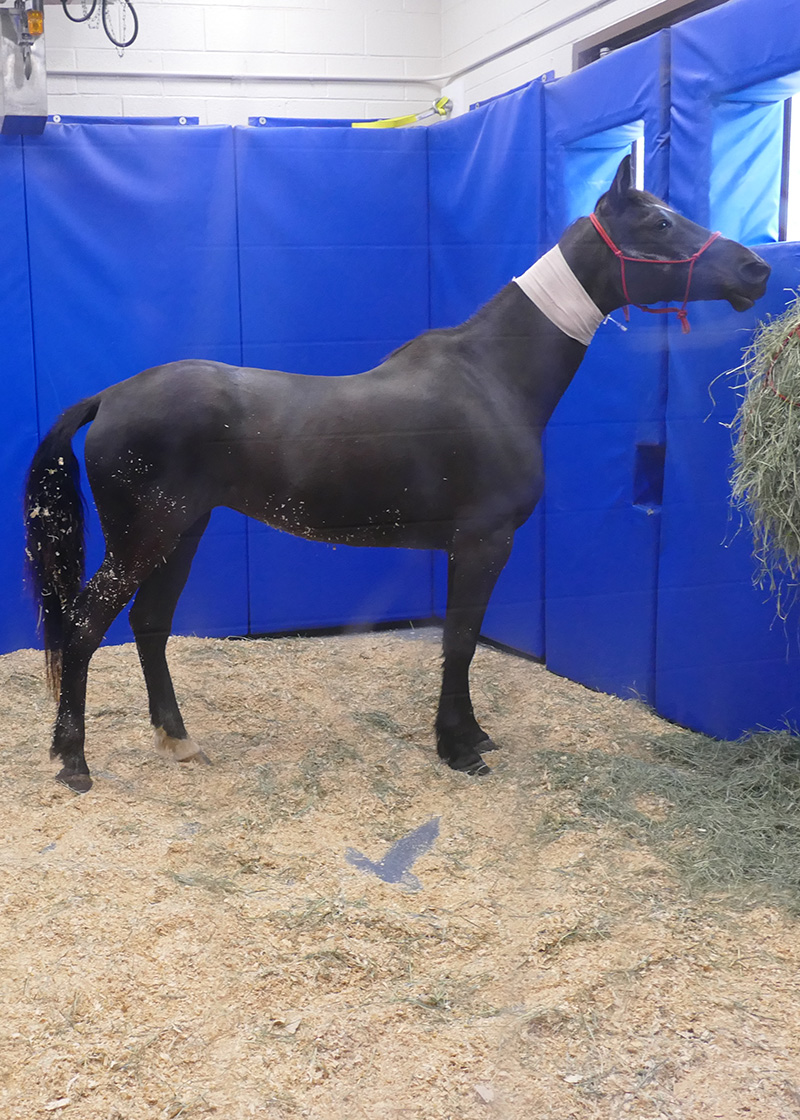Sadie, a retired Amish buggy horse, is treated for neurologic disease
July 19, 2022

When Tracie Karonis of Lovettsville, Virginia arranged for her 25 year old Standardbred mare Sadie to get her annual vaccinations, she didn’t anticipate an emergency visit to the Marion duPont Scott Equine Medical Center (EMC).
Mia Lee of Solstice Equine arrived at the farm to administer vaccinations and witnessed Sadie fall down in her stall. Sadie showed symptoms of severe neurological issues and hind end weakness in addition to a spiked temperature and a high respiratory rate and effort. Lee immediately referred Sadie to the EMC for emergency neurologic evaluation, treatment, and care.
Clinical assistant professor of equine medicine Krista Estell and her clinical support team performed a thorough neurologic exam, noting Sadie’s behavior and mentation, posture, muscle symmetry, stance, and tail and anal tone. Sadie was extremely sensitive to palpation of her cervical spine, was reticent to turn or lift her head bilaterally, and had an abnormal stance.
During the full gait analysis, Estell noted that Sadie displayed proprioceptive deficits in her hindlimbs and had difficulty turning without swinging her hind legs; her body couldn’t sense movement, action, and location well. Her front limbs also showed deficits with hypermetria, a coordination and balance muscle disorder characterized by overreaching.
Sadie tested negative for EHV-1, but her blood work revealed an elevated blood cell count and other abnormalities, indicating chronic inflammation and infection, possibly attributed to a tick-borne disease. Ultrasound of Sadie’s lungs showed that she might also be suffering from bronchopneumonia.

It was apparent that Sadie needed to be admitted for hospitalized treatment. She slowly walked into the EMC’s ‘Just Java’ Neuro Stall, which is part of the Biosecurity Level Two Isolation Unit. This specialized facility is designed to house unstable patients like Sadie. The double-size stall with fully padded walls, non-slip flooring, and an overhead sling system keeps patients safely on their feet and protected from further injury during their treatments.
Sadie was started on continuous intravenous fluid therapy, systemic antibiotics and anti-inflammatories, and vitamin E and EPM-specific treatment. She was placed in the Center’s Anderson sling for the first 48 hours of treatment, and overnight she remained quiet and comfortable. After 24 hours, she was brighter and more comfortable, and her respiratory rate and effort were markedly improved. She was walked into the building for thoracic radiographs, and Estell noted that her neurologic deficits had also improved.
Karonis was thrilled, as Sadie is very special to her. In a past life, Sadie worked hard as a “school bus” buggy horse in Indiana, ferrying her young charges to school and back each day. Now, at 25, her past work life has taken a physical toll.
Tracie Karonis shared, “Sadie and I had an immediate and deep connection from the first moment we met last September. Maybe because we are both survivors, she has been through a lot in her life and still kept an open heart. Her loving, kind, and fearless nature amazes me daily – she truly is my heart!”
After five days of hospitalization, Sadie was bright and stable, and her physical exam was within normal limits. She was ready to return home for continued treatment under the care of her loving owner, who said of the experience, “The care that Sadie received at the Equine Medical Center was top-notch. They were able to stabilize, assess, and identify her lung condition, and give us an excellent treatment plan for further care at home. She especially enjoys her inhaler!”








